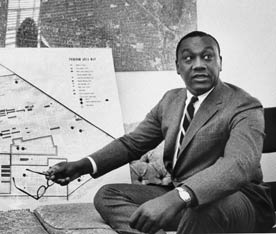Today’s leaders must balance:
- People-based versus place-based solutions — Should a CDO focus on providing services, training and empowerment to people who might leave the neighborhood, or should it focus on improving conditions in the neighborhood, even if that doesn’t have an immediate impact on the lives of residents. As a neighborhood revitalizes (or gentrifies, depending on your perspective), what responsibilities does a community organization have to the more well-off residents of the neighborhood?
- Professional versus grassroots orientation — Would a community organization be better off promoting staff who come from the community, even if they don’t have the same business skills as someone who might come out of a graduate program or another type of organization?
- The desire to serve a home community versus the desire to generate more revenue by expanding outward — A typical organization in the 1960s or 1970s worked in a single neighborhood. Today, several large community development organizations build housing or provide services in multiple neighborhoods. How much of an organization’s limited resources should be spent on serving residents in the home community today instead of serving others to make money for tomorrow?
Another challenge is the growing ethnic and cultural diversity of workers, communities, and organizations in the 21st century. The diversity means a lot of people with different views about work styles, behaviors, and priorities for the organization. One of the more common conflicts cited by experts in nonprofit management is between professionals who came of age in the 1960s and those who began their careers 20 or more years later. Older professionals, inspired by the idealism of the civil-rights movement and following in the footsteps of World War II-era parents who made many sacrifices, tended to see their work as a calling that required an enormous commitment of time and energy. Younger professionals are also committed to the goals of community development, but tend to want more of a balance of work and life.
According to Patrick Corvington, a senior associate at the Annie E. Casey Foundation who began its leadership development unit, younger professionals gravitate toward organizations that are transparent and participatory. They also want work that has prestige, performance-based compensation, challenging and interesting assignments, and opportunities for advancement and the acquisition of new skills. What may appear to an older professional to be a lack of commitment or even selfishness may seem to a younger professional to be a set of reasonable expectations.
Thus, just as a band’s sound can be richer with more musicians and instruments, the 21st-century community development professional benefits by building the capacity of staff and residents to become leaders.
“I’ve seen one formula for success — organizers who become charismatic leaders and gain the business acumen to take their organizations to scale,” McCarthy said. “What remains to be seen is whether another formula for success is possible — a leader with business acumen who can gain organizing skills and become a charismatic leader.”
These tensions are particular challenging for captains focused on sustaining their ships and preachers focused on reaching their vision. One of the things that preachers and captains have in common is that they stand apart from their colleagues — the preacher at the pulpit, the captain barking orders from the pilot house. Today’s band leader is likely to be one of the musicians, and not necessarily the lead singer. That type of leader excels by allowing and helping other musicians to perform at their highest level — and gives them some opportunities to shine in the spotlight.
The effective leader of the 21st century, said nonprofit organizational consultant Mark Levine, is someone who “gives up control to build power.” Levine demonstrated the idea — drawn from the work of Harvard public policy lecturer Marshall Ganz — at a recent NeighborWorks symposium with a graphic of Ganz’s “leadership-rich” structure that puts the executive in the middle, not at the top, of a network of leaders. A leadership-rich organization, Ganz and Levine argue, has the internal strength to thrive even in difficult times. In Levine’s view, the bandleader’s job is to build the ensemble.
As Rodney Fernandez anticipates stepping down as Cabrillo’s executive director, he recognizes the value of building a leadership-rich team as a key to the sustaining the group’s effectiveness. Determined to create that kind of structure, he is modeling the essential attributes of the 21st-century community development professional leader for his staff: paying attention to professional workforce and organizational development, staying attuned to the community’s needs, and knowing when to step out of the spotlight so others can grow.
At the symposium, Fernandez demonstrated that he’s walking the walk. A leader from Cabrillo Economic Development Corporation was a featured speaker—but it wasn’t Fernandez (although he was there). It was Jill Bangser Fioravanti, a special projects manager. Fernandez is working to ensure that the ensemble he’s building keeps performing after he’s left the stage.






Comments